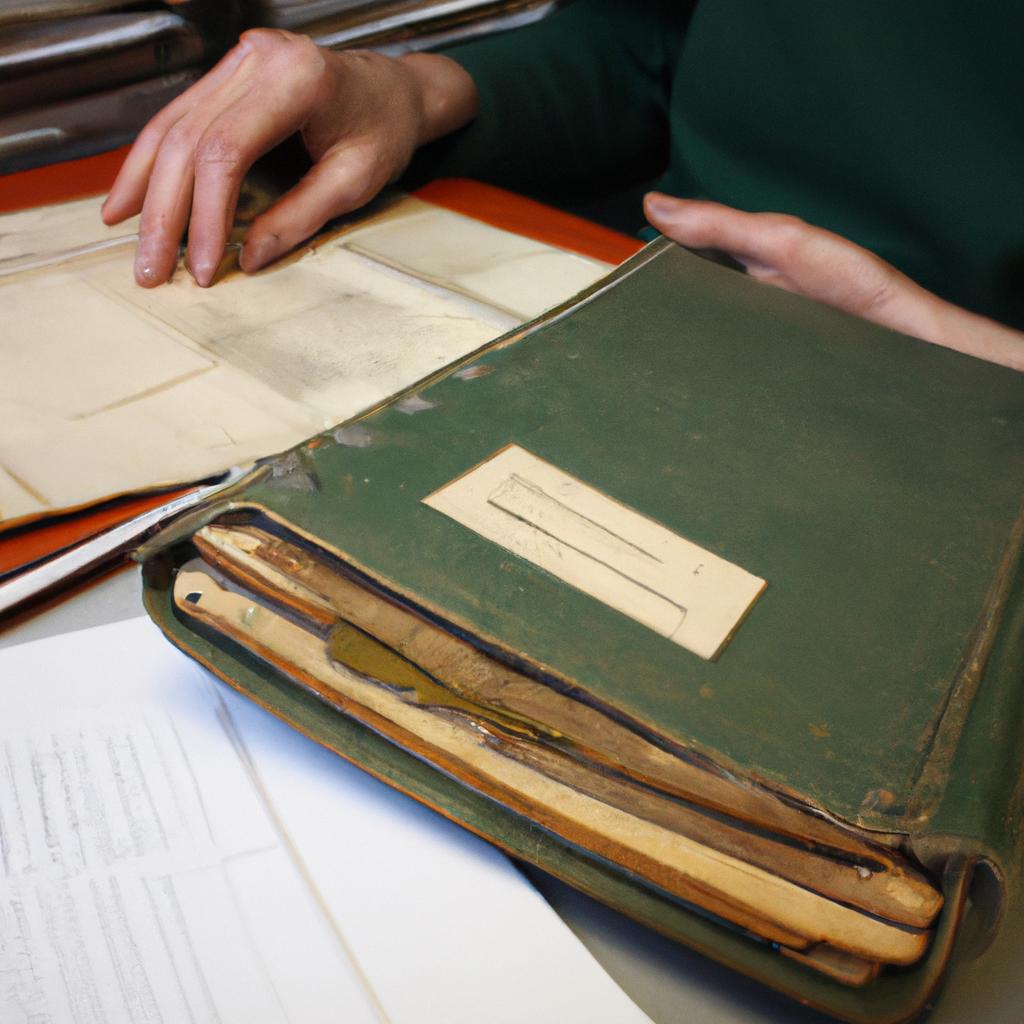In the realm of genealogy research, census records serve as invaluable resources for tracing ancestral lineages and gaining insight into historical contexts. These records provide a wealth of information about individuals and families, offering glimpses into their occupations, residences, relationships, and even personal characteristics. However, effectively utilizing census records in genealogical education requires diligent record keeping practices to ensure accuracy and organization. This article aims to guide researchers in developing efficient strategies for managing census data through comprehensive record keeping techniques.
Consider the case of Sarah Thompson, a dedicated genealogist seeking to uncover her family history. Armed with limited knowledge about her ancestors, she embarks on a journey to piece together fragments of the past using various sources – one being census records. As Sarah delves into these documents spanning decades, she encounters challenges that hinder her progress: missing or incomplete entries, inconsistent spellings of names, and discrepancies in ages or birthplaces. Frustrated by these obstacles, she realizes the importance of maintaining meticulous records throughout her research process.
To address such predicaments faced by aspiring genealogists like Sarah, this article will delve into the significance of effective record keeping when working with census materials. By exploring key principles and practical methods for organizing and documenting findings from census records, researchers can streamline their genealogical efforts, minimize errors, and maximize the potential of census records in uncovering ancestral connections.
One essential principle of effective record keeping is consistency. Maintaining a standardized format for recording information from census records ensures clarity and ease of retrieval. Researchers should establish a template that includes relevant details such as names, ages, birthplaces, occupations, and relationships. Consistently using this template across all census records helps to establish patterns and identify potential discrepancies or inconsistencies.
Another crucial aspect of record keeping is accurately citing sources. Genealogists must document the specific census record they are referencing, including the year, location, enumeration district (if applicable), page number, and any other pertinent identifiers. This allows for easy cross-referencing and verification of information.
In addition to consistent formatting and proper citation practices, organizing census data in a logical manner is vital. This can be achieved through various methods such as creating spreadsheets or databases to store recorded information. These tools provide flexibility in sorting and filtering data based on different criteria like surname or location.
To address challenges like missing or incomplete entries in census records, researchers should make note of these gaps in their documentation. They can use placeholders or annotations to indicate missing information rather than making assumptions or leaving blanks. Additionally, it may be helpful to consult alternate sources like city directories or tax records to fill in any gaps left by incomplete census entries.
Furthermore, when encountering inconsistent spellings of names or discrepancies in ages or birthplaces within census records, researchers must exercise caution. It is crucial not to jump to conclusions but instead consider possible explanations such as variations in spelling due to language barriers or transcription errors during data entry. Keeping detailed notes about these discrepancies will aid future analysis and potentially lead to breakthroughs.
Lastly, maintaining backups of all research materials is imperative for safeguarding against accidental loss or damage. Whether it’s physical copies or digital files stored securely in multiple locations, backups ensure that valuable census data is not lost.
By implementing these principles and practical methods for organizing and documenting findings from census records, researchers like Sarah can enhance their genealogical endeavors. Effective record keeping allows for a systematic approach to analyzing census data, enabling more accurate interpretations and discoveries about ancestral lineages.
Understanding Census Records
Imagine you are a genealogist searching for information about your great-grandparents. You have gathered various documents, such as birth certificates and marriage records, but there is still missing information that could provide valuable insights into their lives. This is where census records come into play. By examining these comprehensive surveys conducted at regular intervals by government authorities, researchers can gain a deeper understanding of their ancestors’ socio-economic status, family structure, and migration patterns.
Census records offer a wealth of information that can help bridge the gaps in our knowledge of past generations. They serve as snapshots of specific moments in time, providing details about individuals residing within a particular geographic area. Through careful analysis of this data, genealogists can piece together intricate narratives that shed light on ancestral origins, occupational pursuits, and social affiliations.
To illustrate the importance of census records in genealogy research, consider the following bullet points:
- Census records allow us to trace family lineages back several generations.
- They reveal changes in household composition over time due to births or deaths.
- These records indicate economic shifts experienced by families and communities.
- Census data enables identification of migration patterns across regions or countries.
The table below summarizes some key elements found in census records:
| Column 1 | Column 2 | Column 3 | Column 4 |
|---|---|---|---|
| Name | Age | Occupation | Birthplace |
| John Smith | 45 | Farmer | Ohio |
| Mary Johnson | 32 | Seamstress | New York |
| Robert Davis | 60 | Blacksmith | Pennsylvania |
| Sarah Thompson | 19 | Housemaid | Virginia |
By immersing ourselves in the intricacies of these historical documents, we enhance our ability to connect with previous generations. Census records provide valuable insights into the lives of our ancestors, enabling us to learn from their experiences and appreciate the challenges they faced. In the subsequent section, we will explore further the importance of census records in genealogy research, delving deeper into how this information can enrich our understanding of family history.
Importance of Census Records in Genealogy
Understanding Census Records: A Key Component of Genealogy Research
Now, let us delve deeper into understanding these valuable resources and how they can aid you in your quest to trace your family lineage.
To illustrate the practicality of census records, consider this hypothetical scenario: You have been trying to track down information about your great-great-grandfather, James Anderson. Through meticulous examination of various documents and records, you have managed to piece together his life up until a certain point. However, there is a significant gap that needs filling – you are unable to locate any record or mention of him after 1850. This is where census records become indispensable.
Census records offer crucial insights into individuals’ lives by providing a snapshot of their household at specific points in time. By examining such records, researchers may uncover details like names, ages, occupations, relationships between family members, immigration status, and even ethnic backgrounds. The more comprehensive the collection of census data available for analysis, the higher the likelihood of successfully tracing ancestors through multiple generations.
The benefits offered by census records extend beyond individual discoveries; they contribute significantly to broader historical narratives as well. Here are some key advantages:
- Demographic Analysis: Census data enables historians and sociologists to study population trends over time, shedding light on patterns related to migration movements, social changes within communities, and economic shifts.
- Social Context: Understanding societal structures requires an exploration of communal norms and living conditions. Census records paint a vivid picture of people’s day-to-day realities regarding housing types, literacy rates among different groups, employment statistics across industries and professions.
- Genealogical Connections: Census data allows descendants to connect with distant relatives they might not have known existed otherwise. Discovering shared ancestry can foster a sense of belonging and build bridges between extended families spread across different parts of the world.
- Preservation of Heritage: Census records serve as a tangible record of our collective past, preserving the stories and experiences of previous generations. They provide an opportunity to honor and remember those who came before us.
By recognizing the significance of census records in genealogy research, we can unlock invaluable information that may have otherwise remained hidden.
Types of Information Found in Census Records
Case Study:
To illustrate the practical significance of census records in genealogy, let us consider a hypothetical scenario. Imagine that you are tracing the ancestral roots of a family living in a small town called Greenwood. By examining various census records, you discover an individual named John Thompson who resides in Greenwood during the 1850s. This information becomes a vital clue to uncovering his descendants and understanding their migration patterns.
Exploring Census Records:
- Rich Historical Context: Census records provide valuable insights into social, economic, and demographic aspects of past communities.
- Familial Connections: These records offer glimpses into familial relationships by capturing household composition, including names, ages, genders, and sometimes even occupations.
- Tracking Migration Patterns: Census data can help trace the movement of individuals or families across different locations over time.
- Uncovering Lost Histories: Census records contribute to filling gaps in historical narratives by documenting marginalized populations often overlooked in other sources.
Emotional Impact Table:
| Emotion | Example | Importance |
|---|---|---|
| Empathy | Discovering details about ancestors’ hardships evokes compassion and fosters connections | Personalizes history |
| Curiosity | Prompting further investigations through intriguing discoveries | Stimulates intellectual curiosity |
| Gratitude | Appreciating the sacrifices made by ancestors | Deepens appreciation for one’s heritage |
| Belonging | Fostering a sense of identity and belonging within a larger historical context | Strengthens personal connection to family and community |
By utilizing census records effectively, researchers gain access to an abundant array of information that helps piece together intricate family histories. The exploration of these invaluable resources not only unveils fascinating stories but also generates emotional responses rooted in empathy, curiosity, gratitude, and belonging. With this foundation established, we can now delve into the practical tips for conducting effective census record research, which will further enhance your genealogical journey.
Tips for Effective Census Record Research
Having explored the types of information that can be found in census records, it is now important to understand how to effectively conduct research using these invaluable resources. To illustrate this process, let’s consider a case study involving an individual named John Anderson, who sets out to trace his family history through census records.
John begins by accessing online databases and platforms dedicated to genealogy research. He locates a digital copy of the 1880 United States Federal Census and discovers his great-grandparents listed as residents of New York City. This initial discovery sparks his curiosity and motivates him to delve deeper into his lineage.
To ensure effective research, here are some recommended practices when working with census records:
- Take detailed notes: Documenting relevant details from each record will not only help you track your findings but also facilitate future analysis.
- Cross-reference multiple sources: Verify information obtained from one census record against other available documents such as birth certificates or marriage licenses to establish accuracy and avoid potential inaccuracies.
- Pay attention to neighboring households: Examining nearby families within the same community may reveal useful connections or provide contextual insights about your ancestors’ lives.
- Consider variations in names and spellings: Due to clerical errors or individuals adopting different names throughout their lifetime, it is crucial to remain flexible when searching for specific ancestors.
Case Study Example:
| Name | Age | Occupation |
|---|---|---|
| John Anderson | 35 | Carpenter |
| Mary Anderson | 30 | Housewife |
| Sarah Anderson | 8 | |
| William Anderson | 6 |
In conclusion, understanding how to navigate census records is imperative in genealogical research. By following best practices like taking thorough notes, cross-referencing data, examining neighboring households, and accounting for name variations, researchers like John Anderson can effectively piece together their family history.
Building upon our understanding of conducting effective research using census records, let’s now delve into the crucial step of organizing and analyzing the wealth of information obtained from these records.
Organizing and Analyzing Census Data
In the previous section, we explored various strategies to enhance your census record research. Now, let’s delve into the crucial aspect of organizing and analyzing the data you gather. To illustrate this process, consider a hypothetical case study involving Sarah Johnson, an amateur genealogist researching her family history.
Once Sarah has collected multiple census records pertaining to different ancestors, she must organize them systematically. This ensures that valuable information is not overlooked or duplicated. One effective approach is to create a spreadsheet with columns representing key details such as name, age, occupation, and place of birth. By inputting this data in a structured manner, Sarah can easily compare and identify patterns across multiple records.
To further facilitate analysis, it is helpful to categorize census records based on specific criteria. For instance, Sarah may choose to group records by decade or geographic location. Such organization allows her to gain insights into demographic changes over time or spot migration trends within her lineage. Additionally, creating separate folders for each ancestor helps maintain clarity and prevents confusion when referring back to specific individuals.
Analyzing census data involves more than just compiling information; it requires critical thinking and contextualization. The following bullet points highlight essential steps that will aid researchers like Sarah in extracting meaningful insights from their findings:
- Compare occupations: Analyze the occupational choices of different family members across generations to discern trends related to socioeconomic status or societal shifts.
- Track residence changes: Observe how frequently families moved residences between censuses as this can provide clues about economic opportunities or significant events affecting their lives.
- Examine household composition: Pay attention to who lived together under one roof during each census year. Changes in household structure can offer hints about marriage patterns, extended family relationships, or economic circumstances.
- Study literacy rates: Explore variations in literacy levels among family members throughout the years – this might reflect changing educational opportunities available at the time.
Now equipped with organized and analyzed census records, researchers like Sarah can move forward in utilizing this valuable data to deepen their genealogical knowledge. The subsequent section will discuss how census records can be effectively integrated into genealogy education, providing invaluable insights that go beyond mere names and dates.
Utilizing Census Records in Genealogy Education
Section H2: Organizing and Analyzing Census Data
In the previous section, we explored the importance of organizing and analyzing census data in genealogical research. Now, let’s delve deeper into how to effectively utilize census records in genealogy education.
Case Study:
To illustrate the significance of utilizing census records, let’s consider a hypothetical example involving a genealogy student named Sarah. Sarah is researching her family history and comes across an ancestor named John Smith. Through careful examination of multiple census records, Sarah discovers that John Smith lived in various states throughout his life, providing valuable clues about his migration patterns and potential connections to other family members.
Utilizing Census Records:
-
Tracking Family Movements: Census records can serve as a roadmap for tracing your ancestors’ movements over time. By carefully examining the addresses listed on different census years, you can gain insights into their geographical mobility, enabling you to uncover new branches or confirm existing ones within your family tree.
-
Identifying Relationships: Census records often include information about individuals residing at the same address. This allows researchers to identify potential family relationships such as spouses, children, siblings, or extended relatives living together. Such findings enhance not only our understanding of familial dynamics but also provide opportunities for further exploration through additional record searches.
-
Uncovering Occupations and Social Status: Another significant aspect of using census records is the ability to discover your ancestors’ occupations and social status during specific time periods. This information provides context and enriches their personal narratives by shedding light on their economic circumstances, educational backgrounds, and social standing within their communities.
-
Tracing Changes Over Time: Comparing data from different census years enables researchers to analyze changes in household composition, marital status, birth rates, or even immigration patterns within a particular lineage. These comparisons help paint a more comprehensive picture of our ancestors’ lives while highlighting societal shifts that may have influenced them.
Table – Example Comparison Between Census Years:
| 1850 Census | 1870 Census | 1890 Census | |
|---|---|---|---|
| Name | John Smith | John Smith | J. W. Smith |
| Age | 30 | 50 | Not listed |
| Address | New York | Ohio | Illinois |
| Occupation | Farmer | Carpenter | Laborer |
Through effective record keeping and analysis, Sarah was able to piece together her ancestor’s journey from New York to Ohio and finally settling in Illinois. This information not only expanded her family tree but also provided valuable insights into the economic changes that may have influenced their decisions.
In summary, utilizing census records is a vital component of genealogy education. By tracking family movements, identifying relationships, uncovering occupations and social status, as well as tracing changes over time, researchers can construct more comprehensive narratives about their ancestors’ lives. The case study involving Sarah highlights the potential discoveries waiting to be made through diligent examination of these invaluable resources.





